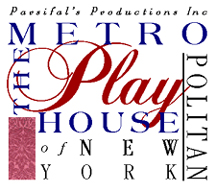nytheatre.con
Reviewed by Martin Denton - October 7,
2004
Afraid
that a 175-year-old American melodrama may not have much relevance to
your
life? Sample this bit of dialogue from Metamora,
or The Last of the Wampanoags:
We
are
informed that thou gavest shelter to a banished
man, whose deeds unchristian met our just reproof--one by our holy
synod
doomed--whom it is said you housed, and thereby hast incurred our
church's
censure--and given just cause to doubt thy honesty.
Or,
to put it another way: if you're not for
us, you're against us. What's ever new
under the sun?—to Metropolitan Playhouse, producers of this fascinating
revival, goes my extreme gratitude, for reminding us that we can run,
but we
can't hide, from our shared social history.
Metamora, written in 1829 by a
playwright that you have probably never heard of named John Augustus
Stone,
takes place in Massachusetts Bay Colony in 1677 and tells a
fictionalized
version of the story of Metacom (called King Phillip by the colonists),
leader
of the local Wampanoag tribe and antagonist of the early
American-Indian
conflict called King Phillip's War. In the play, Metamora and his wife
Nahmeokee find themselves making a last stand against the English
settlers who
have taken over their ancestral land. Leading the charge against them
are
Eddington, chief of the colonists' governing council, and a new arrival
from
England, Lord Fitzarnold; caught in the middle are Walter, an orphan
who
respects Metamora greatly, and Oceana, the beautiful young woman Walter
loves.
Further complicating matters is the fact that Fitzarnold intends to wed
Oceana
himself, and because of some murky but important information that he
possesses
about that lady's father, Mordaunt, he seems likely to get his way.
One
of the most interesting things about this play is the rather
spectacular contrast
between the way it tells the story of Oceana's romantic affairs and the
way it
treats the tragic demise of Metamora. The former feels like vintage
melodrama,
hopelessly naive and clichéd—Fitzarnold may as well twirl a
handlebar moustache
and tie Oceana to a railroad track, for all the nuance and motivation
that he's
allowed here.
But
the treatment of the Indian King is something else again. Stone was a
contemporary of James Fenimore Cooper (The
Last of the Mohicans came out in 1826), and his Metamora is the
same kind
of "noble savage" that Cooper immortalized. He is in almost every way
a model citizen—loyal, trustworthy, and so on—and a splendid tragic
hero,
choosing to die bravely as the last of his line rather than yield to
the White Men's
entreaties to assimilate.
Except,
of course, that he's also portrayed as a murderous villain—a heathen
who
refuses to accept the "gift" of Christianity and thinks nothing of
destroying his enemies or taking truly awful vengeance when he thinks
he has
been wronged. For all the admirable qualities that Stone gives his
leading
character, he never lets us forget—via the foolishly stilted language
that
became the model for 150 years of "Red Man" talk in plays and movies,
through Tonto and beyond; and via the willful stereotyping that equates
un-Englishness with backward barbarianism—that Metamora is one of
"them," i.e., the bad guys. Neither Stone nor, I reckon, anybody whom
he expected to be in an audience watching this play could ever imagine
something other than an American manifest destiny: the savage is noble
by
virtue of his willingness to step aside and let the foreigners conquer
his
land.
Are
we still so romantic? I wonder how a play that cast a Muslim suicide
bomber as
a modern-day "noble savage" would be received—by either side.
Alex
Roe, Metropolitan's artistic director, has staged this revival in a way
that
puts its old-fashioned-ness right up front. He's charged set designer
Ryan
Scott to build a jewel box-style stage on the Metropolitan's floor,
framed by a
very conspicuous proscenium arch and ringed by old-time footlights
(lighting is
by Douglas Filomena). The actors wear heavy pancake-y makeup and some
perform
in the broad manner we associate with 19th century melodrama. The
effect of all
of this is to remind us continuously that we are observing not just a
play but
a whole bygone world—this ambience makes us confront the America that
adored
theatre like Metamora as well as this
specific drama itself.
It's
a risky choice that mostly pays off. I got irritated with the actors
who
overplayed—evoking, sometimes, laughs that were certainly unintended by
Stone—but I loved the homely simplicity of the design and staging.
Matthew
Trumbull and Adriane Erdos are nothing short of triumphant as Metamora
and
Nahmeokee, creating characters we admire and respect, despite the
ridiculous
way Stone makes them speak and the ultimately demeaning things he makes
them
do. These actors, and Roe, justify the
gamble of mounting this obscure play, making the attitudes of nearly
two
centuries ago live and breathe, and showing us—as this kind of theatre
always
does, better than almost anything I know of—how far we've come as a
nation...
and how far we still have to go.

